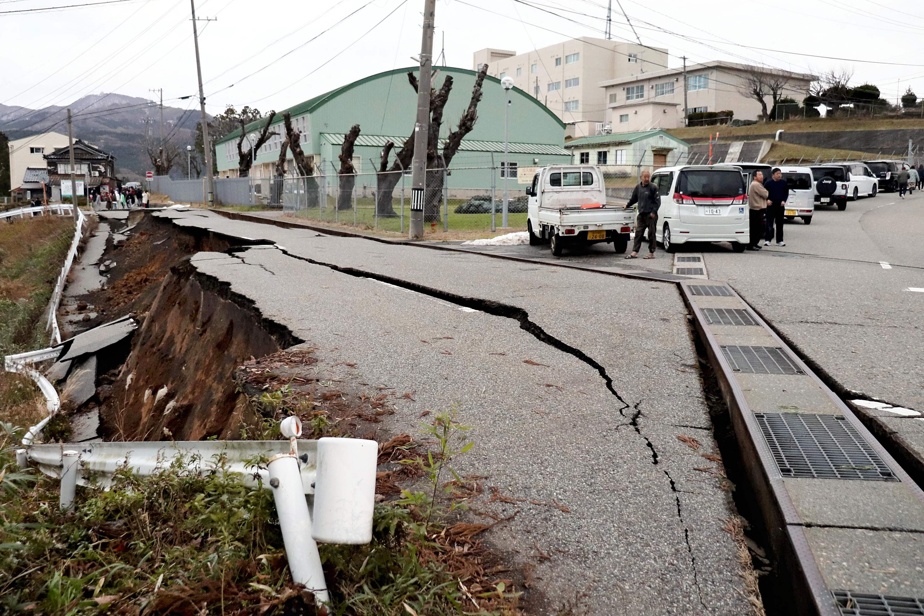(Kanazawa) The powerful and numerous earthquakes which struck central Japan on Monday left at least six dead according to local police, as well as significant material damage, while a tsunami that arrived in the wake remained of small magnitude.
The largest of these earthquakes, which occurred Monday shortly after 4 p.m. (2 a.m. Eastern Time) in Ishikawa Prefecture, was recorded at a magnitude of 7.5 by the United States Institute of Geophysics (USGS). and 7.6 by the Japan Meteorological Agency (JMA).
This violent shock, clearly felt as far away as Tokyo, more than 300 km away as the crow flies, led to a tsunami on Monday on the coast of the Sea of Japan, forcing many residents to run and seek refuge in higher ground as quickly as possible. .
The waves fortunately remained low, despite a maximum alert level initially issued by the JMA: they were measured at 1.2 meters in the port of Wajima, in the Noto peninsula, at the northern tip of the department of Ishikawa.
The tsunami risk level was then downgraded, then permanently lifted at 10 a.m. Tuesday (8 p.m. Eastern Time) by the JMA.
Ishikawa Prefecture was rocked by 155 earthquakes between 4 p.m. Monday and 9 a.m. Tuesday (7 p.m. Eastern Time Monday), most with a magnitude greater than 3.0, the same agency recorded.
The earthquakes caused “many casualties” and significant material damage, with collapsed buildings and fires, Japanese Prime Minister Fumio Kishida said on Tuesday. “We must race against time” to save lives, he added.
Fires continued to rage Tuesday morning in Wajima, a small historic town known for its lacquerware crafts.
Firefighters are overwhelmed, a Wajima emergency services official told AFP on Tuesday. “We’re dealing with several fires,” and the number of emergency calls and damage reports continues to rise, he said.
A large, multi-story building of a local lacquer manufacturer notably collapsed, he added.

PHOTO YUSUKE FUKUHARA, AGENCE FRANCE-PRESSE
People sit outside after evacuating buildings in the town of Wajima.
Reinforcement soldiers
Aerial views showed the extent of the disaster from a large fire in Wajima and fishing boats sunk or grounded in Suzu, another port on the Noto Peninsula.
Nearly 32,700 homes remained without electricity Tuesday morning, according to a local electricity supplier.
Tens of thousands of residents have had to evacuate since Monday, according to the national fire and natural disaster management agency cited by the Japanese news agency Kyodo.
A thousand soldiers from the Japan Self-Defense Forces (JSF) as well as more than 2,000 firefighters and some 630 police officers have arrived as reinforcements in the disaster areas, added Mr. Kishida.
The Prime Minister also announced on Monday the sending of essential goods such as drinking water, food, blankets, gasoline and even fuel oil, by plane or by boat.
For his part, American President Joe Biden said that the United States stood “ready to provide any necessary assistance to the Japanese people”, recalling that Washington and Tokyo were “close allies”.
“Solidarity with Japan which must overcome the consequences of strong earthquakes. We share the immense pain of the families of the victims,” French President Emmanuel Macron reacted on X, adding that France was also ready to help.

SCREENSHOT KYODO NEWS, VIA ASSOCIATED PRESS
A screenshot from a video shows a fire following an earthquake in Wajima, Japan.
“This is the Matsunami district of Noto. We are in a horrible situation. Please come help us. My city is in a horrible situation,” implored one person in a video posted Monday on X where old wooden houses could be seen collapsed.
Other images from Japanese television on Monday showed evacuees waiting outside in the cold, some covering themselves with thick blankets, others holding children.
Faced with the disaster, the traditional public New Year greetings by Japan’s Emperor Naruhito and his family, which were to be held in Tokyo on Tuesday, were canceled.
Nuclear power plants resisted
Several highways near the epicenters were closed to traffic, and high-speed train (Shinkansen) traffic between Tokyo and Ishikawa was interrupted on Monday.
Located on the Pacific Ring of Fire, Japan is one of the countries with the most frequent earthquakes in the world.
The archipelago therefore has extremely strict construction standards, so modern buildings are generally resistant to powerful earthquakes, but older houses much less so.
But Japan is haunted by the memory of the terrible 9.0 magnitude earthquake followed by a giant tsunami in March 2011 on the northeastern coast of the country, a disaster which left some 20,000 dead and missing.
This disaster also led to the Fukushima nuclear accident, the worst since Chernobyl in 1986.
“No anomaly” has been detected in the country’s nuclear power plants, the Japanese nuclear safety authority (NRA) assured on Monday.
